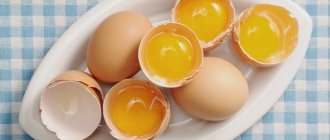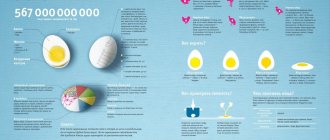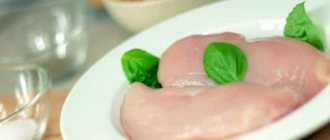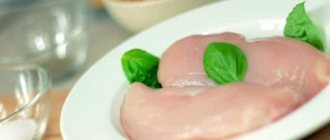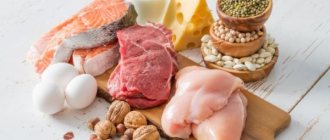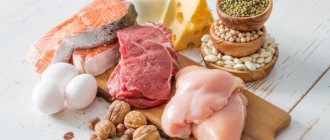What are the benefits of egg white? How much is there in one egg? Is the yolk harmful? What is the best way to prepare this product? Long before the abundance of sports proteins, ordinary chicken eggs were an indispensable source of protein for athletes. Neither meat, nor fish, nor even the revered chicken could provide what the athlete received from proteins and yolks. It is not surprising that since then millions of people have been asking the following questions: how much protein is in one egg, how to cook them correctly, are yolks harmful, etc.
With all the information, you can skillfully include the most easily digestible source of natural protein in your diet, compensating for the lack of proteins without risk to health. But to do this, you need to know not only how many grams of protein are in 1 egg, but also the answers to some other questions.
Ideal protein
Chicken eggs would not be so popular among athletes if it were only the amount of protein they contained. After all, the amount of protein in an egg does not exceed 6-7 grams , and any meat chop will surpass this figure.
But unlike chops, fish and chicken dishes, eggs also have other valuable qualities:
- maximum protein absorption;
- minimum carbohydrates and fats;
- ease of preparation.
Let's look at each item in more detail to evaluate the benefits of the product as part of a regular diet.
Harm or peculiarities of use
Chicken products can also be harmful to health. If a person is allergic to protein components, one should be wary of consuming it. If you have high cholesterol, you can eat them without the yolk; it is not necessary to exclude them from the diet completely. After all, there is no cholesterol in the protein shell at all.
To prevent these foods from harming your health, you do not need to overeat them. It is enough for a healthy adult to consume 2-3 pieces per day, and this will not harm the body. Children are enough to eat 1 piece.
It is important to remember that a dangerous microbe, salmonella, can lurk in a raw egg. Before use, you need to wash the shell with soap. In its raw form, protein is poorly absorbed by the body and brings little benefit, and sometimes causes harm: it reduces hemoglobin and contributes to the development of vitamin deficiency.
Easy protein absorption
More experienced athletes and professional nutritionists know that it is not the initial amount of a particular element in a product that is important, but the completeness of its absorption. From some types of meat, protein is absorbed only 60% of the original volume, and from plant sources - even worse.
But chicken eggs are the absolute champions in this matter. 95% of all protein will be absorbed by the body without loss!
So what is important is not only how many grams of protein are in an egg, but that all these grams are fully absorbed.
Chemical composition of egg yolk
On average, the yolk accounts for 33% of the total egg volume. It contains 100% fat-soluble vitamins, carotenoids and 90% microelements.
Chemical composition:
| Name | norm, mg per day | chicken, mg | quail, mg | goose, mg | ostrich, mg |
| water | 2273 g | 74.1 g | 73 g | 70.83 g | 51.6 g |
| ash | — | 1 g | 1.2 g | 1.14 g | 0.9 g |
| beta carotene | 5 | 0,06 | 0,08 | 0,013 | 36,6 |
| vitamin A | 900 mcg | 250 mcg | 483 mcg | 187 mcg | 195 mcg |
| vitamin E | 15 | 2 | 0,9 | 1,34 | 1,05 |
| phosphorus | 800 | 192 | 218 | 208 | 198 |
| sodium | 1300 | 140 | 115 | 138 | 142 |
| calcium | 1000 | 55 | 54 | 60 | 56 |
| choline | 500 | 251 | 507 | 263,4 | 293,8 |
We recommend that you familiarize yourself with BZHU starch
Eggs are an excellent preventative against premature aging. Vitamin D and all B vitamins help reduce the manifestations of aging of the body. It also contains iodine, sulfur, potassium, essential amino acids, and polyunsaturated amino acids.
Only protein and nothing extra
A caveat needs to be made here. The minimum fat and carbohydrate content is valid only for egg whites. But the yolk contains a fairly decent amount of fat, so it is not very suitable as a dietary product. But don’t rush to throw the yolks in the trash! They will come in handy when gaining muscle mass.
It is especially noteworthy that the answer to the question of how much protein is contained in one egg will always be almost the same, regardless of the methods of its preparation. Raw, boiled or fried eggs - they will be almost the same in terms of protein volume . But there will be enough differences in the quality of the amino acid profile, which will be discussed below.
Boiled eggs on rats' menu: benefit or harm?
Domestic rats enjoy eating boiled eggs. Therefore, some owners treat their little pets to this delicacy almost every day, believing that it is good for their body and gives their fur shine and a well-groomed appearance.
This product is truly a healthy and nutritious treat for cute animals, but if used incorrectly, it can be harmful to the health of the animal.

You can avoid this by adhering to several rules:
- Rodents may be allergic to this product. Therefore, when offering eggs to rats for the first time, it is necessary to observe whether the animal has an allergic reaction (itching, redness of the skin);
- adult pets are fed a boiled egg no more than once a week;
- small rats can be given such a treat once every three to four days;
- Rats prefer boiled egg yolks to whites. But the animal may choke on the yolk and before feeding it is advisable to dilute it with a small amount of water or milk;
- It is not recommended to give fried eggs to pets, as they are prepared with the addition of sunflower or vegetable oil, which is harmful to the liver of rodents;
- We should also not forget that these foods are quite high in calories and their excessive consumption can lead to the development of obesity in the animal.
Important: rodents should not be fed salty, hot or spiced foods, so you should not give them eggs from your table, for example, stuffed or covered in sauce.
Making Egg White Easy
Eggs are one of the few foods that can be eaten in any form of preparation. Moreover, each of these forms is accessible even to a convinced bachelor who is far from culinary delights.
And although the protein content is always unchanged and equal to approximately 6-7 grams , its usefulness greatly depends on the preparation of the final product.
From top to bottom, most valuable to least useful:
- raw eggs;
- soft-boiled;
- in a bag;
- hard-boiled;
- fried eggs.
In other words, the more active the heat treatment, the less benefit the consumption brings to the body . The reason is simple - the amino acid profile is destroyed under high temperatures.
Despite this, it is not recommended to eat chicken eggs raw. They can be the source of diseases such as salmonellosis. Minimal heat treatment (soft-boiled) will protect you from diseases without significantly harming the quality of the product.
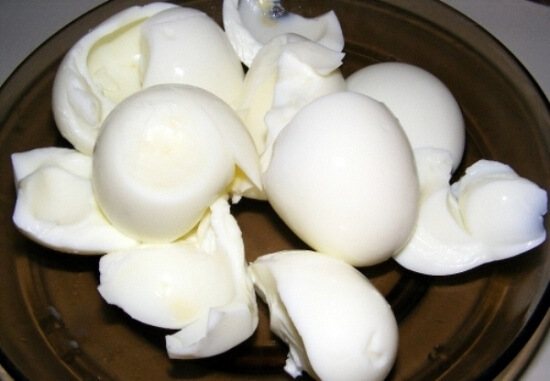
How does heat treatment affect the quality of the protein shell?
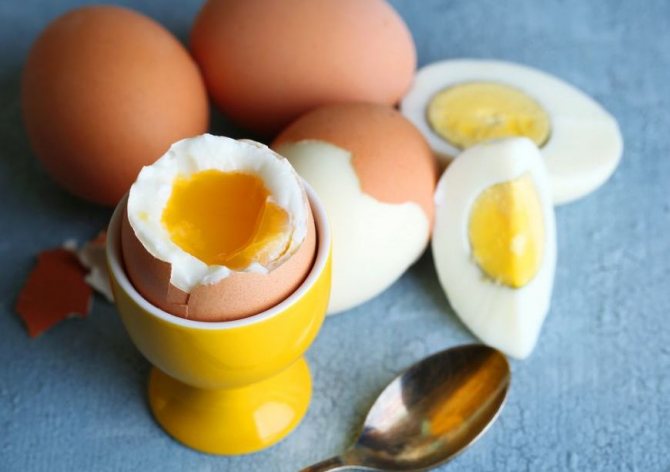
Protein protein contains all 9 amino acids in the correct ratio. How much of it the body can absorb is directly related to the method of preparation. If you drink it raw, only 50% of the protein will be absorbed, and if you eat it boiled, the body will absorb all 90%.
Cooking is divided into several degrees of heat treatment: hard-boiled, soft-boiled, in a bag, fried and melange. A detailed table is presented showing how much protein is obtained in a chicken egg.
| Type of prepared product | Quantity/gram |
| Hard-boiled | 12,7 |
| Soft-boiled | 12, 9 |
| In a bag | about 13 |
| Fried without oil | 14,5 |
| Melange | 12, 4 |
Chicken products are often consumed in ready-made dishes; they are rarely eaten raw. They are quite simple and quick to prepare. It is recommended to study several dishes recommended by nutritionists for athletes and those losing weight. Naturally, these recipes are also suitable for ordinary people:
- Boiled. If you want soft-boiled, you need to keep the egg in boiling water for 2-3 minutes; hard-boiled will turn out after 7-8 minutes of cooking.
- Fried. You can prepare fried eggs by breaking several pieces into a heated frying pan, after pouring a little oil into it. You need to fry without damaging the integrity of the yolk, you can turn it over. DO NOT forget to add salt and pepper. If you mix it, you get scrambled eggs - also a delicious dish.
- Omelette. A very healthy dish. It is prepared from egg ingredients beaten with milk. Add salt and pepper and fry in a greased frying pan. For taste, you can add fresh sweet peppers, tomatoes, ham and cheese.
- Poached. Boil water, add vinegar to it and pour the contents of a chicken egg into it, swirling the water into a small whirlpool with a spoon. The product is not cooked until fully cooked; the yolk should be half-baked.
It’s not difficult to choose a recipe to suit your taste. The main thing is that the dish brings benefits and taste pleasure.
Benefits and harms
But is it safe to eat chicken eggs? Professional athletes gobble up dozens of them a week, but now we are still talking about mere mortals.
In fact, the harm of egg yolks in terms of cholesterol accumulation has been greatly exaggerated! Moreover, high-density lipoproteins are reduced in the blood of a person who regularly eats eggs. That is, there is no danger to the heart and blood vessels when eating the product.
Another thing is that there is a lot of fat in an egg - several grams. All fats are concentrated in the yolk, which is also digested for at least 3 hours in the stomach. This composition greatly complicates digestion and puts an end to the rest of the diet in matters of weight loss.
But eating whole eggs (along with the yolk) is indicated when gaining muscle mass. The fats contained are needed to increase anabolism in the body and better assimilate the proteins entering it.
Bzhu and kbju yolk of 1 egg
The yolk is a real leader in vitamin A content, its content is 260 mcg. The vitamin has a positive effect on the functioning of the male reproductive system. They contain a lot of choline, which helps brain function, stimulates the nervous system, helps cope with excess weight, and normalizes fat metabolism. It is useful for women as it contains a lot of iron, which is important for regular blood loss. And all this with low energy values.
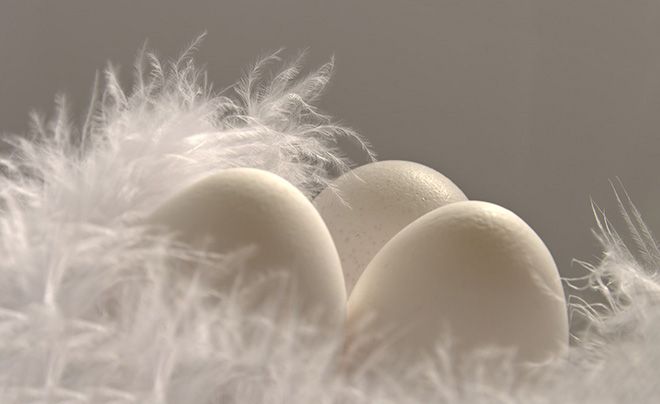
Chicken
A chicken egg weighs on average from 35 to 77 g. Kbju yolk per 100 g:
- 4.0 g proteins;
- 12.0 g fat;
- 1 g carbohydrates.
Nutritional value – 225.0 kcal or 941 kJ. With an average yolk weight of 20 g, it is easy to calculate that with moderate consumption, no harm will be done to the figure.
We recommend that you familiarize yourself with the BZHU pasta
When fried or boiled, the calorie content increases and is equal to 358 kcal per 100 g.
Quail
This product is considered dietary and suitable for baby food. But we must remember that the cholesterol content in quail is higher, but there are fewer calories. They are 4-5 times smaller in size than chicken ones. The yolk is also high in vitamin A and choline.
Bju yolk per 100 g:
- 13.1 g protein;
- 12.0 g fat;
- 0 g carbohydrates.
Nutritional value is 168 kcal or 703 kJ. There are 844.0 g of cholesterol per 100 g, so people with heart disease should avoid consuming this product. In terms of the risk of contracting salmonellosis, quail is the safest, although you can never be 100% sure.
Gusinogo
This product is approximately 4 times larger than chicken products, and the average weight is 200 g. It is difficult to find them in stores, since geese do not lay eggs as often as chickens. It is not customary to consume them raw, since these poultry are not known for their cleanliness, so there is a high risk of contracting salmonellosis. Boiled and fried, they can be safely consumed, just increase the heat treatment time.
We recommend that you familiarize yourself with the BZHU of zucchini
Bzhu 100 g of yolk equals:
- 13.9 g protein;
- 13.3 g fat;
- 1.4 g carbohydrates.
Calorie content – 185 kcal, ratio 1:1:0.1 or 31%/66%/3%.

Ostrich
Ostriches lay eggs only in the warm months of the year, and their size can reach 2.2 kg, the minimum value is 1.2 kg, which is equal to 25-36 chicken eggs. The yolk of ostriches is small - about 350 g. Compared with chicken, ostriches have minimal calorie content and a relatively low amount of cholesterol, that is, they are the optimal product for maintaining a figure.
But it will take more than an hour to boil 1 egg. The product can be stored for up to 3 months, but if the shell is at least partially opened, it must be used within 3 days.
Bju yolk per 100 g:
- 12.2 g protein;
- 11.7 g fat;
- 0.70 g carbohydrates.
Calorie content -118 kcal or 493 kJ.
Beneficial features
The benefits of daily consumption are very great:
- Improve metabolism;
- Relieve tension and stress;
- Increase visual acuity;
- Saturate the body with essential amino acids;
- Strengthen bone tissue;
- Prevents the development of cancer;
- Normalizes liver function;
- Improves memory;
- Positively affects blood circulation;
- Strengthens the cardiovascular system.
We told you how much protein is contained in one egg - add the product to your diet without fear, eat it for breakfast and lunch. As long as you stay within your daily allowance, you can get exceptional benefits from every bite!
Effect on the human body
Despite the enormous benefits, some people are not recommended to eat chicken eggs. Usually associated with individual intolerance to the product. In some cases, the product simply should not be abused, while in other cases it is completely excluded from the diet. If you get very involved in eating eggs , after a while you can talk about:
- elevated cholesterol levels;
- copious secretion of bile;
- improper functioning of the gastrointestinal tract.
It is recommended to reduce consumption or eliminate it completely in case of the following ailments:
- presence of diathesis;
- urolithiasis;
- weak liver;
- diseases of the circulatory system, such as hepatitis, jaundice, etc.
If you cannot use chicken eggs in your diet, then quail eggs can be an alternative. They are quite small and are completely absorbed by the body.
